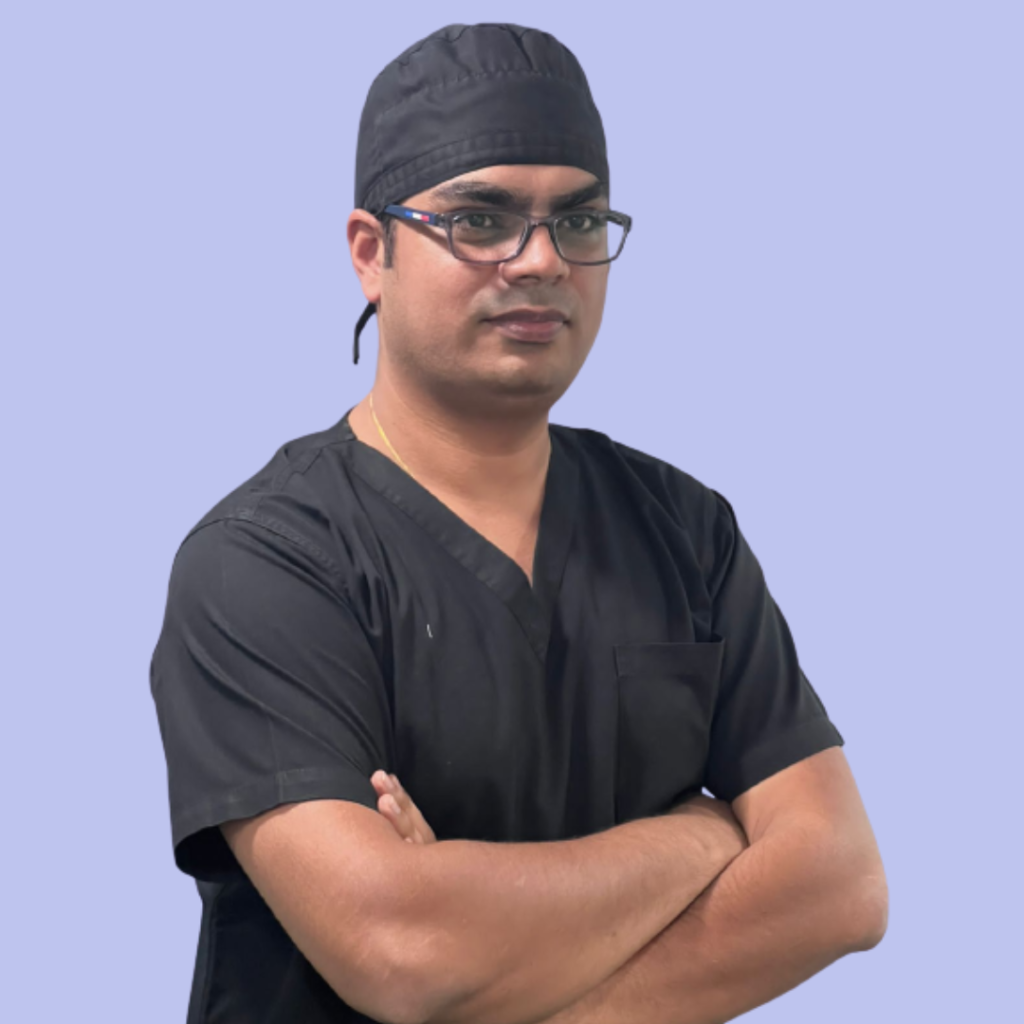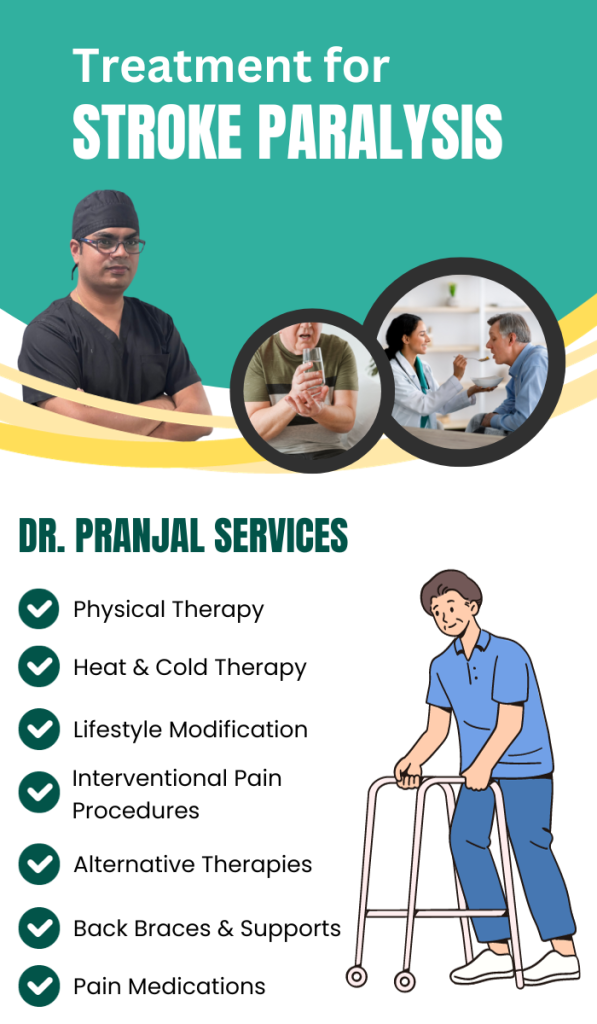Dr. Pranjal Pandey
MBBS, MS (General Surgery), M.Ch. Neurosurgery
A neurosurgeon with over 15 Yrs. years of experience
Awarded as the best resident in Neurosurgery and was a regional & zonal winner at TYSA neurosurgery
Contact Details
ADDRESS: J-203, Basement, Block J, Saket, New Delhi, Delhi 110017, India
PHONE: +91-8800924351
EMAIL: info@drpranjal.com
WORKING DAYS/HOURS: Mon-Sun: 9:00 AM - 8:00 PM

A stroke occurs when blood flow to a portion of the brain is disturbed. It can be said that stroke paralysis is the brain’s version of a heart attack. Strokes are a potentially fatal emergency for which prompt medical intervention is essential to avert irreversible harm or death.
A stroke is also called a cerebrovascular illness because it affects both the brain (cerebro-) and the blood arteries (vascular), which carry blood to the brain. The warning indications of a stroke can be relatively straightforward in certain situations, but the body’s internal workings are highly intricate.
Dr. Pranjal Pandey has made significant strides in stroke paralysis management. His team of neurosurgeons in Delhi excels in the early detection of stroke symptoms and delivers optimal stroke treatment.
If your family member has experienced a similar situation, it’s time to contact Dr. Pranjal Pandey, renowned as the top neurosurgeon in Delhi. With over a decade of specialized experience in neurology, Dr. Pandey provides swift access to emergency medical assistance. Seeking his consultation promptly can reduce the risk of brain damage and other complications resulting from a stroke.
Understanding Stroke Paralysis Reasons
Stroke paralysis may occur as a result of cerebral hemorrhage or clogged blood vessels. The brain cells there begin to lose oxygen when there isn’t a constant blood flow.
The inability of a muscle or group of muscles to move is known as paralysis, and it is one of the most prevalent ailments following a stroke. In some form or another, 90% of stroke patients experience paralysis.
There are two types of strokes:
- Hemorrhagic strokes
- Ischemic strokes
Survivors are encouraged to explore various paralysis treatments as individuals respond differently to each.
When blood flow to the brain is halted for more than a few seconds, depriving it of oxygen and blood, brain cells can die, resulting in the loss of functions controlled by that part of the brain. Timely treatment enhances the chances of recovering from a stroke without disability.

Who is at Risk of Stroke Paralysis?
Although everyone can suffer a stroke, certain factors can increase your risk. However, certain things can reduce your risk, too.
Strokes can happen to anyone at any age, from young children to older people. However, as you age, your risk of stroke rises because of physiological changes, including atherosclerosis or the loss of artery flexibility.
But, because women live longer than males, they are more likely to suffer a stroke!
Post-menopausal hormones, specific birth control, and pregnancy difficulties increase the risk of stroke. Genetics can include hereditary disorders that raise your risk of stroke or a family history of the condition. A person’s risk of experiencing another brain event, such as a stroke or T.I.A., is significantly increased. Other factors include being overweight, not exercising, consuming large amounts of alcohol, and using drugs recreationally. Additionally, there is an increased risk for those who smoke, have high blood pressure or cholesterol, poorly controlled diabetes, or certain types of cardiac disease.
However, many risk factors for stroke don’t have any symptoms. Following Dr. Pranjal Pandey, brain specialists’ advice is crucial for a good brain stroke recovery. Consult him if you are having any uncomfortable symptoms.
Symptoms and Causes of Stroke Paralysis
The National Stroke Association advises keeping the acronym F.A.S.T. in mind. It stands for Face, Arms, Speech, and Time. The part of the brain affected by a stroke will determine the paralysis symptoms you experience.
Suddenly losing strength or feeling numb in the arm, leg, or face, especially on one side of the body, difficulty in understanding or speaking, abrupt vision problems in one or both eyes, abrupt difficulty in moving, usually intense headaches with vomiting and dizziness, unable to walk or loss of coordination, unstable emotions and shifts in personality, etc.
If you think that you or someone you know is showing symptoms of brain stroke, note when the symptoms started and rush to Dr. Pandey, the best neurosurgeon in Delhi, as soon as possible. You can reach him anytime in an emergency. He will give you the best advice on the course of treatment. The medication developed by stroke specialist Dr. Pranjal Pandey is reasonably successful in treating strokes. He can customize the treatment data according to your situation, considering your circumstances, medical history, and more.
Treating Stroke Paralysis with Dr. Pranjal Pandey
The approaches of stroke paralysis treatment under paralysis specialists and expert neurosurgeon Dr. Pranjal Pandey are:
Acute Medical Management:
Timely medical intervention is critical during the acute phase of a stroke. The goal of treating an ischemic stroke is to clear the blockage and start the brain’s blood flow again. The better the result, the earlier the medicine is administered. Dr. Pranjal Pandey works to stop aneurysms and arteriovenous malformations from rupturing and leaking blood before a hemorrhagic stroke occurs.
Rehabilitation:
Following a spinal or brain stroke, rehabilitation begins immediately and should be continued once the patient is discharged. The goal of rehabilitation paralysis therapy is to increase coordination, strength, and motor abilities. Dr. Pandey aims to help the patient become as independent as feasible with this therapy.
Electrical Stimulation:
Functional electrical stimulation, or F.E.S., may be utilized in certain situations to stimulate and enhance the function of the afflicted muscles. It works significantly better when electrical stimulation and stroke exercises are combined. Even foot drop and post-stroke muscular atrophy can be addressed with electrical stimulation.
Deep brain stimulation (D.B.S.):
Brain Stimulation Therapy is a surgical technique that stimulates specific brain regions directly with electrodes. Brain stimulation therapy comes in several forms, such as vagus nerve stimulation (V.N.S.), electroconvulsive therapy (E.C.T.), etc. In recent years, brain stimulation has emerged as one of the most widely accepted therapies for treating brain strokes.
Other than the above, many different therapies, like constraint-induced movement therapy (C.I.M.T.), Virtual Reality Therapy, etc, are provided by Dr. Pranjal Pandey in Delhi. He holds the credentials of M.B.B.S., MS (General Surgery), and M.Ch. Neurosurgery has won awards for being the best resident in the discipline and regional and zonal honors from T.Y.S.A. Neurosurgery.
Brain specialist Dr. Pranjal Pandey utilizes neurological examinations, diagnostic imaging, and other procedures to diagnose strokes. He emphasizes that educating patients and their families about strokes is the crucial first step toward receiving appropriate therapy. Dr. Pandey’s team comprises highly skilled professionals who specialize in medical stroke treatment in Delhi.
Most interventional treatments must be initiated within 8 hours of onset, except for stroke complications. Some treatments require prompt initiation soon after symptoms appear. The treatment approach for a stroke is influenced by various factors, with the type of stroke being the most significant. Long-term stroke treatments are also available, with some individuals recovering within six months through appropriate rehabilitation, while others may require more time.
Seeking immediate medical assistance from Dr. Pandey is crucial for potentially life-saving. If your loved ones are displaying symptoms of a stroke, contacting Dr. Pranjal Pandey promptly is recommended.
